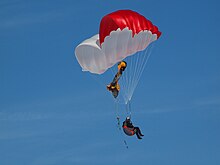Rogallo wing
The Rogallo wing belongs to the group of flexible wings and was invented in 1948 by the Rogallo couple .
construction
The Rogallo wing consists of two parallel, semi-conical surfaces that are aligned in the direction of flight. Depending on the flight speeds desired in flight, the cones are either wide open for low speeds or the cones are narrow if high speeds are to be achieved.
The flexible wings have the great advantage that they are less prone to turbulence, as they gently cushion it. Furthermore, the flexibility results in an advantage in terms of longitudinal stability , because the wing tip is flexible . Thus, a tail unit is no longer absolutely necessary for good longitudinal stability.
use
In the early 1960s, Barry Palmer and John Dickenson, ignorant of each other, took up the idea of the Rogallo grand piano. The concept found a practical application in the experimental aircraft Ryan Flex Wing , which was developed for the US Army. The Rogallo wing was also to be used as a return system for the Gemini space capsule in space travel . However, later in 1964 another possibility of retrieval was found using round canopy parachutes.
On May 18, 1987 and July 7, 1988, at night, refugees from Czechoslovakia crossed the Iron Curtain with a self-made Rogallo grand piano and landed in Austria.
Nowadays, in addition to the classic round canopies, Rogallo wings are used as controllable rescue systems for paragliders .
control
The Rogallo wing is weight-controlled, that is, by shifting the center of gravity both forwards and backwards as well as sideways, it is possible to change direction. The most common way of flying by shifting the center of gravity was by leaning on two parallel bars with your forearms.
Videos
Web links
Individual evidence
- ↑ Source: EU information board in the Skalky Mountains near the Czech town of Mikulov
- ↑ Peter Bruggmüller: Rogallo rescue. (pdf; 305 kB) Butterfly to steer. (No longer available online.) In: Gleitschirm-Magazin 7/2003. Pp. 36-40 , archived from the original on July 8, 2015 ; Retrieved June 17, 2011 . Info: The archive link was inserted automatically and has not yet been checked. Please check the original and archive link according to the instructions and then remove this notice.


